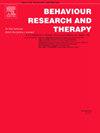图像描述的生理特征:心率与会话水平结果之间的关系。
IF 4.5
2区 心理学
Q1 PSYCHOLOGY, CLINICAL
引用次数: 0
摘要
目的:意象重写(IR)作为一种以情绪为中心的技术,包括一个唤起和一个重写阶段,其中包括认知重构。IR的不同成分可能具有不同的生理模式。本研究的主要目的是检验来访者在唤起阶段的生理唤醒和在重写阶段的生理唤醒是否遵循特定的模式,并预测下一次治疗结果的改善。方法:结果是基于108个治疗疗程的图像为基础的治疗64个客户的测试焦虑。治疗方案包括两个连续的与考试焦虑相关的过去事件的IR会话。持续监测患者的心率(HR),用状态测试焦虑量表和结果评定量表评估下一阶段的结果。结果:在第一次IR会话中,客户平均表现出在唤起阶段的HR增加和在重新描述阶段的HR减少。这些影响在第二次IR治疗中减少。此外,未发现潜在亚群。此外,在唤起阶段,人力资源的增加与较低的下一次考试焦虑显著相关,与较高的下一次考试幸福感轻微相关。结论:本研究结果初步证明,来访者在心理刺激诱发阶段的生理觉醒可能对心理刺激的有效性起作用。本文章由计算机程序翻译,如有差异,请以英文原文为准。
The physiological signature of imagery rescripting: Associations between heart rate and session-level outcomes
Objective
Imagery rescripting (IR) as an emotion-focused technique involves an evoking as well as a rescripting phase, which incorporates cognitive restructuring. The different components of IR might be characterized by different physiological patterns. The main aim of this study is to test whether clients' physiological arousal during the evoking phase and clients’ physiological arousal during the rescripting phase follows specific patterns and predicts improvement on next-session outcomes.
Methods
The results are based on 108 therapy sessions from an imagery-based treatment with 64 clients with test anxiety. The treatment protocol involves two consecutive IR sessions of past events related to test anxiety. Clients’ heart rate (HR) was continuously monitored, next-session outcome was assessed with the State Test Anxiety Measure and Outcome Rating Scale.
Results
Clients showed on average an increase in HR during the evoking phase and a decrease during the rescripting phase in the first IR session. These effects reduced in the second IR session. In addition, no latent subgroups were identified. Furthermore, an increase in HR during the evoking phase was significantly associated with lower next-session test anxiety and marginally associated with higher next-session well-being.
Conclusion
The results provide initial evidence that clients’ physiological arousal during the evoking phase of IR might play a role in the effectiveness of IR.
求助全文
通过发布文献求助,成功后即可免费获取论文全文。
去求助
来源期刊

Behaviour Research and Therapy
PSYCHOLOGY, CLINICAL-
CiteScore
7.50
自引率
7.30%
发文量
148
期刊介绍:
The major focus of Behaviour Research and Therapy is an experimental psychopathology approach to understanding emotional and behavioral disorders and their prevention and treatment, using cognitive, behavioral, and psychophysiological (including neural) methods and models. This includes laboratory-based experimental studies with healthy, at risk and subclinical individuals that inform clinical application as well as studies with clinically severe samples. The following types of submissions are encouraged: theoretical reviews of mechanisms that contribute to psychopathology and that offer new treatment targets; tests of novel, mechanistically focused psychological interventions, especially ones that include theory-driven or experimentally-derived predictors, moderators and mediators; and innovations in dissemination and implementation of evidence-based practices into clinical practice in psychology and associated fields, especially those that target underlying mechanisms or focus on novel approaches to treatment delivery. In addition to traditional psychological disorders, the scope of the journal includes behavioural medicine (e.g., chronic pain). The journal will not consider manuscripts dealing primarily with measurement, psychometric analyses, and personality assessment.
 求助内容:
求助内容: 应助结果提醒方式:
应助结果提醒方式:


